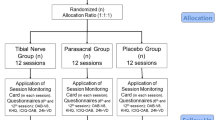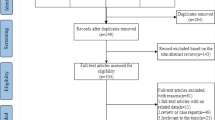Abstract
Introduction and hypothesis
Urgency urinary incontinence (UUI) is highly prevalent in elderly individuals and has a great impact on quality of life. Transcutaneous tibial nerve stimulation (TTNS) can be an effective treatment option for UUI in older women.
Methods
This is a single-center randomized clinical trial with a 12-month follow-up involving 106 women > 60 years of age. Kegel exercises and bladder retraining were performed alone or in combination with TTNS, which consisted of using a transcutaneous electrical nerve stimulator for 30 min once a week for 12 weeks with the following settings: continuous mode, 10 Hz, 200 ms, and 10 to 50 mA (according to hallux mobilization). Responders to therapy who experienced failure during follow-up were invited for a 3-week protocol with the same parameters as those used for the initial therapy. Patients were evaluated at baseline, 4 weeks after the 12-week protocol, and every 3 months for 12 months, through subjective satisfaction questionnaires, a 3-day bladder diary and the International Consultation on Incontinence Questionnaire-Short Form. King’s Health Questionnaire was applied pretreatment and 4 weeks after the last session of the 12-week protocol.
Results
A total of 101 women completed the initial 12-week protocol. TTNS patients reported 66.7% subjective global satisfaction vs. 32.0% in the control group (p < 0.001). The TTNS group showed statistically significant improvement in quality of life (QoL) and UUI parameters compared with the control group. Forty-eight patients were satisfied after the 12-week protocol and completed the 12-month follow-up (32 in the TTNS group and 16 in the control group). A total of 80.5% of responders to TTNS were still satisfied at the end of the 12-month follow-up vs. 30.8% in the control group (p = 0.009).
Conclusion
TTNS is effective at the 12-month follow-up for the treatment of UUI in elderly women.



Similar content being viewed by others
References
Haylen BT, de Ridder D, Freeman RM, Swift SE, Berghmans B, Lee J, et al. An International Urogynecological Association (IUGA)/International Continence Society joint report on the terminology for female pelvic floor dysfunction. Neurourol Urodyn. 2010;29(1):4–20.
Gibbs CF, Johnson TM, Ouslander JG. Office management of geriatric urinary incontinence. Am J Med. 2007;120:211–20.
Booth J, Connelly L, Dickson S, Duncan F, Lawrence M. The effectiveness of transcutaneous tibial nerve stimulation (TTNS) for adults with overactive bladder syndrome: a systematic review. Neurourol Urodyn. 2018;37(2):538–41.
Stewart F, Gameiro LF, El Dib R, Gameiro MO, Kapoor A, Amaro JL. Electrical stimulation with non-implanted electrodes for overactive bladder in adults. Cochrane Database Syst Rev 2016;(12):CD010098. https://doi.org/10.1002/14651858.CD010098.pub4.
Borello-Florence D, Burgio KL. Nonsurgical treatment of urinary incontinence. Clin Obstet Gynecol. 2004;47:70–82.
Skeil D, Thorpe AC. Transcutaneous electrical nerve stimulation in the treatment of neurological patients with urinary symptoms. Br J Urol Int. 2001;88:899–908.
Congregado Ruiz B, Pena Outeiriño XM, Campoy Martinez P, León Dueñas E, Leal López A. Peripheral afferent nerve stimulation for treatment of lower urinary tract irritative symptoms. Eur Urol. 2004;45:65–9.
van Balken MR, Vandoninck V, Gisolf KWH, Vergunst H, Kiemenet LA, Debruyne FM, et al. Posterior tibial nerve stimulation as neuromodulative of lower urinary tract dysfunction. J Urol. 2001;166:914–8.
Amarenco G, Ismael SS, Even-Schneider A, Raibaut P, Demaille-Wlodyka S, Parratte B, et al. Urodynamic effect of acute transcutaneous posterior tibial nerve stimulation in overactive bladder. J Urol. 2003;169:2210–5.
Schreiner L, dos Santos TG, Knorst MR, da Silva Filho IG. Randomized trial of transcutaneous tibial nerve stimulation to treat urge urinary incontinence in older women. Int Urogynecol J Pelvic Floor Dysfunct. 2010 Sep;21(9):1065–70.
DuBeau CE. The aging lower urinary tract. J Urol. 2006;175:S11–5.
Chen GD. Pelvic floor dysfunction in aging women. Taiwan J Obstet Gynecol. 2007;46(4):374–8.
Ozdedeli S, Karapolat H, Akkoc Y. Comparison of intravaginal electrical stimulation and trospium hydrochloride in women with overactive bladder syndrome: a randomized controlled study. Clin Rehabil. 2010 Apr;24(4):342–51.
Berghmans B, Van Waalwijk van Doorn E, Nieman F, de Bie R, van den Brandt P, Van Kerrebroeck P. Efficacy of physical therapeutic modalities in women with proven bladder overactivity. Eur Urol. 2002 Jun;41(6):581–7.
Peters KM, Carrico DJ, Perez-Marrero RA, Khan AU, Wooldrige LS, Davis GL, et al. Randomized trial of percutaneous tibial nerve stimulation versus sham efficacy in the treatment of overactive bladder syndrome: results from the Sumit trial. J Urol. 2010 Apr;183(4):1438–43.
Martinson M, MacDiarmid S, Black E. Cost of neuromodulation therapies for overactive bladder: percutaneous tibial nerve stimulation versus sacral nerve stimulation. J Urol. 2013;189(1):210–6.
Ramirez-Garcia I, Blanco Ratto L, Kauffmann S, Carralero Martínez A, Sánchez E. Efficacy of transcutaneous stimulation of the posterior tibial nerve compared to percutaneous stimulation in idiopathic overactive bladder syndrome: randomized control trial. Neurourol Urodyn. 2019;38(1):261–8.
Author information
Authors and Affiliations
Corresponding author
Ethics declarations
Financial disclosure
None.
Conflicts of interest
None.
Additional information
Publisher’s note
Springer Nature remains neutral with regard to jurisdictional claims in published maps and institutional affiliations.
Rights and permissions
About this article
Cite this article
Schreiner, L., Nygaard, C.C., dos Santos, T.G. et al. Transcutaneous tibial nerve stimulation to treat urgency urinary incontinence in older women: 12-month follow-up of a randomized controlled trial. Int Urogynecol J 32, 687–693 (2021). https://doi.org/10.1007/s00192-020-04560-6
Received:
Accepted:
Published:
Issue Date:
DOI: https://doi.org/10.1007/s00192-020-04560-6




